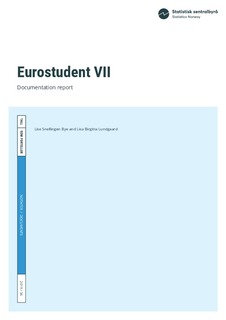| dc.contributor.author | Bye, Lise Snellingen | |
| dc.contributor.author | Lundgaard, Lisa Birgitta | |
| dc.coverage.spatial | Norway | nb_NO |
| dc.date.accessioned | 2019-10-30T09:42:30Z | |
| dc.date.available | 2019-10-30T09:42:30Z | |
| dc.date.issued | 2019-10-17 | |
| dc.identifier.isbn | 978-82-587-1003-2 | |
| dc.identifier.uri | http://hdl.handle.net/11250/2625334 | |
| dc.description.abstract | The Eurostudent survey is conducted every three years. The survey is part of the European Eurostudent survey that is being conducted in about 30 European countries. The aim is to obtain knowledge on students’ living conditions. Statistics Norway has previously conducted the survey in 2010, 2013 and 2016.
The 2019 survey is the seventh wave in Europe, and the fifth time Norway has
delivered data to Eurostudent.
Eurostudent VII was conducted as an online survey by Statistics Norway. In total, 24 000 students were sampled to participate in the survey. The sample was drawn in March 2019 and included students registered at higher education institutions in spring 2019. Prior to the data collection, the Division for Education and Culture
Statistics sent a letter to student media with a view to encouraging students to participate.
Data for Eurostudent VII was collected in the period 24 April–12 May 2019. Most respondents answered the questionnaire within the first week of the data collection period.
About 46.5 per cent of the gross sample answered the survey. A total of 1 684 of the respondents were not part of the target group, either because they were not studying this semester, they were distance learning students or PhD-students. The main reason for non-response was due to not being able to contact the respondents.
Also, some respondents did not want to participate in the survey.
Non-response may lead to sample biases. This means that the net sample does not necessarily represent the target group. This report investigates the potential consequences of non-response for characteristics such as sex, age and region.
Deviations were found between the sexes in the gross and net sample. However, the greatest deviations were found in different age groups. Persons aged 30 years and above are underrepresented, whilst younger people are strongly overrepresented. The data are weighted in the analysis in order to correct the deviations.
The data collected is supplemented with registry information. | nb_NO |
| dc.language.iso | eng | nb_NO |
| dc.publisher | Statistisk sentralbyrå | nb_NO |
| dc.relation.ispartofseries | Notater / Documents;2019/36 | |
| dc.rights | Attribution-NonCommercial-NoDerivatives 4.0 Internasjonal | * |
| dc.rights.uri | http://creativecommons.org/licenses/by-nc-nd/4.0/deed.no | * |
| dc.subject | Eurostudent VII | nb_NO |
| dc.subject | Dokumentasjon | nb_NO |
| dc.title | Eurostudent VII. Documentation report | nb_NO |
| dc.type | Working paper | nb_NO |
| dc.description.version | publishedVersion | nb_NO |
| dc.subject.nsi | VDP::Matematikk og Naturvitenskap: 400::Matematikk: 410::Statistikk: 412 | nb_NO |
| dc.source.pagenumber | 42 | nb_NO |

